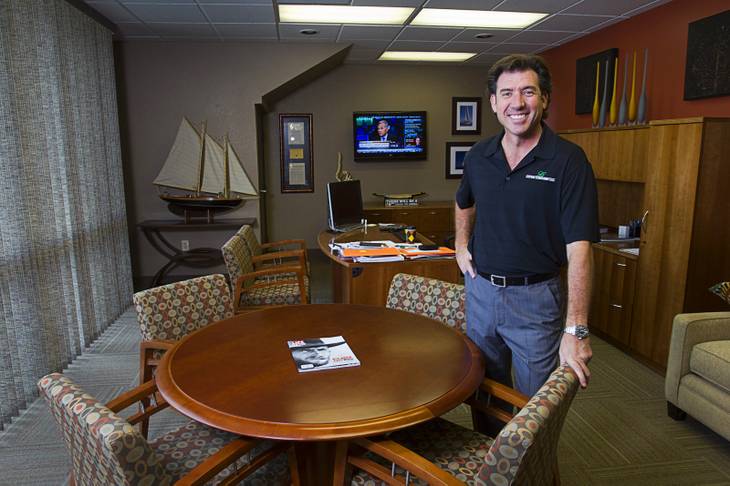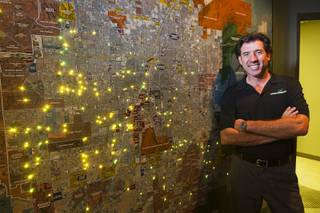Related story
An employee lounge splashed in bold colors. A putting green, soda fountain and popcorn machine. A map of the Las Vegas Valley that lights up like a Christmas tree.
Those are the office amenities employees of Gatski Commercial, a Las Vegas commercial real estate firm, arrive to every day.
Across the valley, The Firm public relations agency has a very different feel. Fountains trickle. Natural light pours in. Stalks of bamboo greet visitors. That company went with a feng shui approach when building its office space.
No matter what particular palette a company chooses, design change can be good for a business. A new look can help reinvigorate a workplace and its employees.
Frank Gatski decided his headquarters needed an update earlier this year.
“We did it for a couple of reasons,” he said. “We had a great 2011 as far as business goes. I could either stick that money in my pocket or reinvest it back into the company. We needed more functional space, so it made sense to make changes. My team is the most important commodity.
Plus, I feel like we got the most bang for our buck in this type of economy.”
Gatski said he spent about $400,000 on the renovations, about 25 percent less than it would have cost in a more stable economy.
Even in tough financial times, experts say business owners are willing to spend money on office redesigns. In fact, redoing a space has become somewhat more popular as people are more hesitant to risk moving in a bad economy.
“What I find is that people tend to stay where they are, and it’s all about giving their business a facelift and a boost,” interior designer Lee Lundquist said. “People are concerned about the dollar more so nowadays. People will still spend money on a piece of art or a sculpture, but it has to be the right piece.”
Gatski had been contemplating interior changes for a while. On the weekends, he said, he’d pop names of successful companies into Google and watch videos about the businesses. Many shared a common theme: interesting office space.
“I constantly want to learn about what these companies are doing and what makes them successful,” Gatski said. “So I explore companies such as Amazon, Zappos, Google itself, and they all are taking about synergy and creating a fun workplace. I decided that we needed that, too.”
Gatski enlisted the help of Lundquist on décor and Lisa Pierce on space planning. Pierce owns Commercial Design Group, while Lundquist works for Amore Interiors.
“Frank’s company has really grown over the years,” Pierce said. “They really needed to update their space. They handle Class A office space all across the city, and their own offices needed to reflect that. Their employees needed to work in that kind of environment.”
Class A space is office space that is highly desirable. It is often brand new or recently redeveloped and generally carries high rents or sales prices.
Gatski’s company expanded into an adjacent office space to open up its floor plan. Construction workers demolished walls, hallways and offices. Conference rooms were equipped with cutting-edge equipment for presentations, and an aerial map of the valley was created to light up each of the 350-plus properties that Gatski employees manage.
When the work was complete, the 11,000 square feet of space employees had used since 2007 had undergone quite a change.
“We really wanted to open things up,” Gatski said. “What sets us apart from our competition is how our team works together. We decided to go with a design that puts our leasing agents right next to our property managers, and our accounting staff is right next to them.”
“I love the synergy that this new office creates,” he continued. “We wanted to try to create a culture and an environment that everyone would enjoy. Our employees now tend to interact more throughout the day, and that makes for a team atmosphere. In the end, that makes us even more successful as a company.”
Fabrics and chair panels were customized with the company’s color scheme. Metal art pieces were incorporated into the entryway. UNLV memorabilia was placed around the building, and a custom door was made.
Then came some of the employee perks. A popcorn and soda machine were delivered, and a cappuccino machine is scheduled to arrive soon. The putting green was put into place, as well. Employees can surf the Internet on staff computers during breaks.
Whereas Gatski wanted fun and excitement in his office, companies such as The Firm seek harmony and tranquility for their workplaces. Feng shui is a common approach they take.
Defined as the ancient Chinese art of placement, feng shui combines elements of fire, earth, metal, water and wood into a home or workplace. The right combination can build harmony and boost success, practitioners say.
A handful of feng shui masters work in Southern Nevada, both on residential and commercial projects. They make a good living, too. At least one charges $200 an hour for business consultation services and requires a two-hour on-site minimum.
Few local feng shui masters were willing to discuss their work with companies, however, fearing they’d violate confidentiality agreements.
Lin Huang, a traditional Chinese feng shui master, has worked in the valley for 25 years, She is a third-generation feng shui practitioner and studied the art with grand masters from the Taoist Temple in Taiwan.
“The first principle in the feng shui philosophy is that every person, place and thing is alive with Qi (pronounced ‘chee’), or vital energy,” said Huang, who owns Qi Gallery, an art gallery on Rainbow Boulevard in Las Vegas. “Along with being molecularly alive, our material possessions are subjectively alive with our thoughts, feelings and associations.”
Every person, place and thing is connected by Qi, Huang said.
“Although our connections are usually strongest with people, places and things that are close by, we are essentially in a relationship with everyone and everything on Earth,” she said. “And the Qi in every person, place and thing is constantly changing. It becomes a gift when we embrace it as a force that can improve our lives.”
Huang said a feng shui master is like a “doctor of the environment.” During business consultations, practitioners study an office’s environment, orientation, layout and occupants. Then they recommend measures to correct any disharmony or imbalances they find.
“In a corporate environment, poor feng shui can result in miscommunication between managers and employees, conflicts among team members and a lack of support for key initiatives,” Huang said. “Individuals can be overlooked for promotions or deserved raises, suffer damage to their reputations or even lose their job. The company may have difficulty attracting or keeping key customers, too.”
Huang said there are a number of ways Qi can be improved in a business. That’s where items such as Fu Dog figurines, a three-legged toad god, mirrors or crystals come into play.
“One of the most beneficial elements to any business is a water feature, such as an aquarium,” Huang said. “It invigorates Qi and invites blessings to flow throughout the property. Classically, aquariums are favored because they gather the five elements — wood (plants), fire (fish), earth (sand), metal (rocks) and water — into one dynamic feature.”
Huang said some of the most common mistakes businesses make involve property location, structural design and placement of furnishings. She said she often finds imbalances in offices’ lighting, coloring or decoration.
“These imbalances can be corrected by using the right colors or adding light to a specific area to activate positive energy, adding a pleasant sound to create a change in energy vibration or placing plants or fish that are alive with energy,” Huang said.

